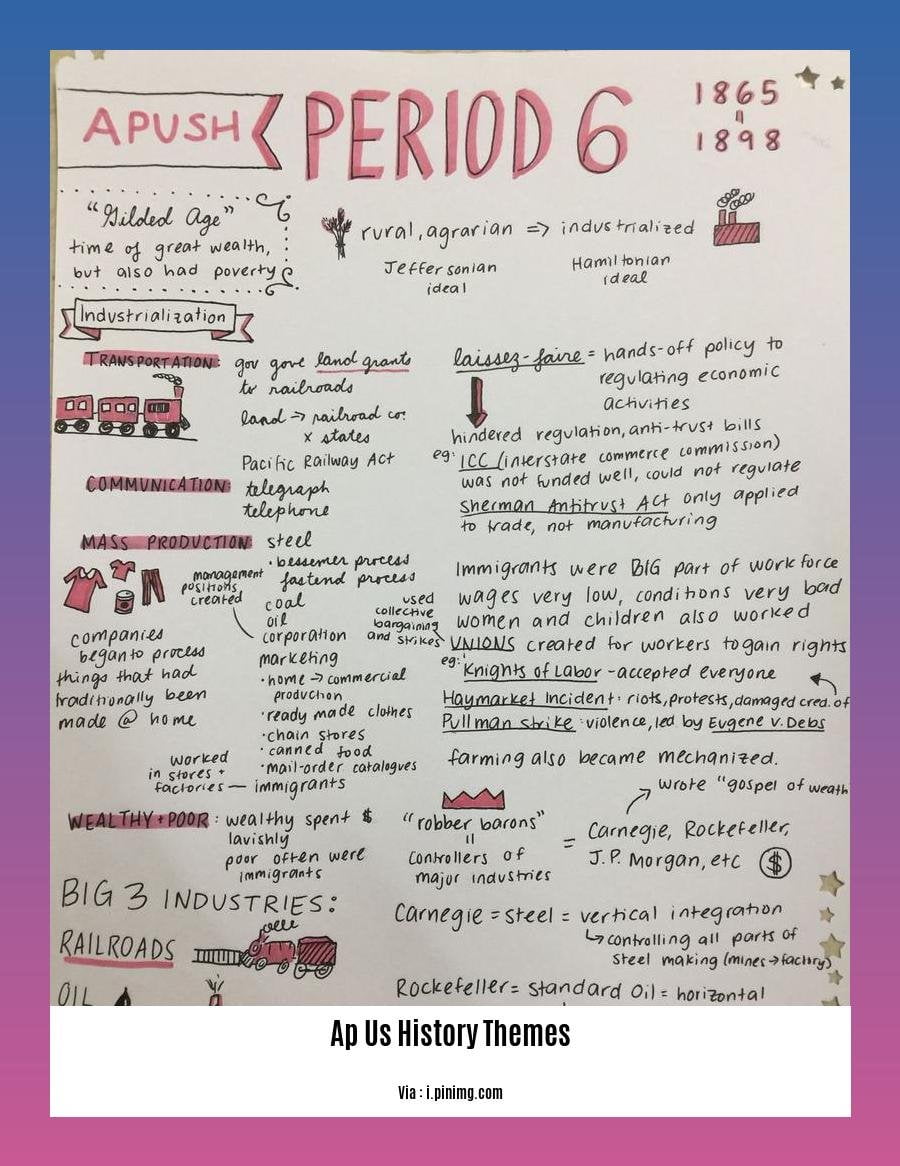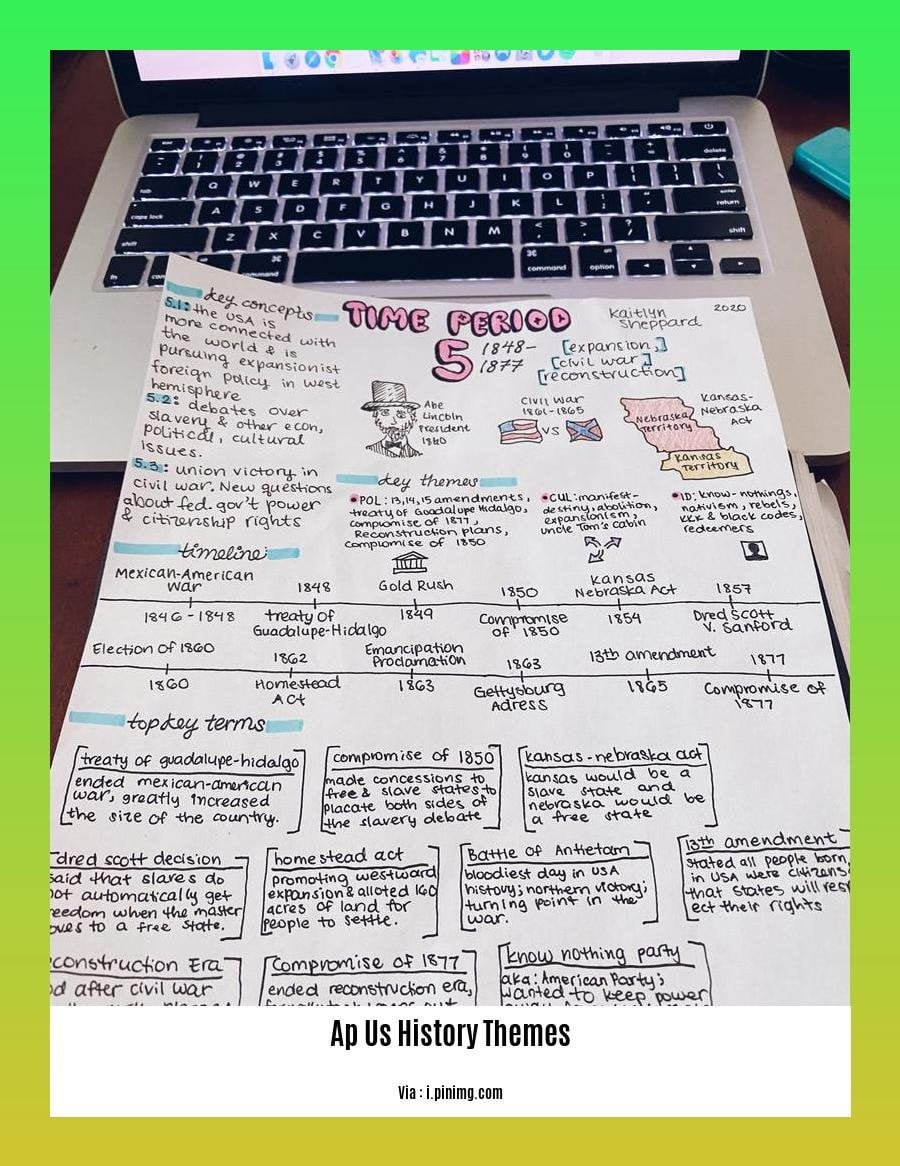In the realm of American history, the College Board’s Advanced Placement (AP) US History course delves into a comprehensive exploration of the nation’s rich past. This article, titled “Analyzing the AP US History Themes: A Historian’s Perspective,” takes a closer look at the framework that guides the AP US History curriculum by examining key themes and their significance in understanding the unfolding narrative of the American experience.
Key Takeaways:
- The AP US History course offers eight themes for students to explore, including American and national identity, work, exchange, and technology, geography and the environment, migration and settlement, politics and power, America in the world, American and regional culture, and social structures.
- Topics covered in the course include the Seven Years’ War, the American Revolution, the Articles of Confederation, the creation and ratification of the Constitution, developing an American identity, and immigration to and migration within America.
AP US History Themes Explained

AP US History is a rigorous course that delves into the rich tapestry of American history, exploring themes that have shaped the nation’s identity and global standing. These themes provide a framework for understanding the complex events, people, and ideas that have influenced the United States over time.
1. American and National Identity
This theme examines the evolution of American identity from the colonial era to the present day. It explores how various groups, including immigrants, enslaved people, women, and Native Americans, have contributed to the formation of a national identity.
2. Work, Exchange, and Technology
This theme investigates the role of labor, trade, and technological advancements in shaping the American economy and society. It examines how industrialization, the rise of corporations, and the development of new technologies have transformed the nation’s workforce and economy.
3. Geography and the Environment
This theme explores the relationship between the American people and their physical environment. It examines how geography has influenced settlement patterns, economic development, and conflicts over land and resources. It also addresses the impact of human activities on the natural environment.
4. Migration and Settlement
This theme examines the patterns and consequences of migration and settlement in American history. It explores the experiences of various immigrant groups, including their motivations for coming to America, the challenges they faced, and their contributions to American society.
5. Politics and Power
This theme investigates the development of American political institutions and the struggles for power among different groups. It examines the evolution of the federal government, the rise of political parties, and the expansion of democracy and civil rights.
6. America in the World
This theme explores America’s evolving role in global affairs. It examines the nation’s foreign policy decisions, its interactions with other countries, and its impact on world events. It also addresses the challenges and opportunities that the United States faces in a globalized world.
7. American and Regional Culture
This theme examines the development of American culture and its regional variations. It explores the influence of various factors, such as immigration, religion, and the frontier, on the formation of American cultural identity. It also addresses the ways in which American culture has influenced and been influenced by other cultures around the world.
8. Social Structures
This theme investigates the social hierarchies and inequalities that have shaped American society. It examines the experiences of different social groups, including women, African Americans, Native Americans, and immigrants, and the struggles for social justice and equality.
By understanding AP US History themes, students gain a deeper appreciation for the complexity and diversity of the American experience. These themes provide a lens through which to analyze historical events and understand how the past has shaped the present.
Delve into the fascinating journey of European history by exploring our comprehensive AP European History notes that provide an in-depth understanding of the major events, movements, and cultural shifts that shaped the continent.
Explore the dynamic history of Apple, from its humble beginnings to its rise as a global tech giant, through our interactive Apple Company History timeline that captures the key milestones and innovations that revolutionized the world of technology.
Enhance your understanding of the significant events that shaped European history with our meticulously crafted AP European History timeline. Discover the interconnectedness of historical eras and the profound impact they have had on the world we live in today.
Examples of Themes in American History

Dive into some captivating examples of themes that weave through the vibrant tapestry of American history:
African Americans: The Unsung Heroes
African Americans have played a pivotal role in shaping the course of American history, from their resilience in the face of slavery to their unwavering fight for civil rights. Notable historical figures like Harriet Tubman and Martin Luther King Jr. embody the spirit of resistance and equality that continues to inspire generations.
Art, Literature, and Popular Culture: Expressing the American Spirit
American culture is a kaleidoscope of diverse artistic expressions, literary masterpieces, and popular trends that reflect the nation’s ever-evolving identity. From the Harlem Renaissance to the counterculture movement of the 1960s, these cultural expressions have shaped the American psyche and continue to influence global popular culture.
Communication and Media: Shaping Public Discourse
The evolution of communication and media in America has transformed the way information is disseminated and consumed. From the printing press to the internet, these advancements have impacted public discourse, politics, and the formation of public opinion, shaping the nation’s understanding of itself and the world.
Key Takeaways:
- African Americans: Their struggle for equality and civil rights has been a driving force in shaping American history.
- Art, Literature, and Popular Culture: These expressions have reflected and influenced American identity and global culture.
- Communication and Media: Advancements in communication have shaped public discourse, politics, and the formation of public opinion.
Citation:
- AP Central: Themes in AP US History
- Important Themes and Topics U.S. History
Impact of Themes on US Development
There’s a reason why history courses and exams focus on themes, right? Themes aren’t just abstract ideas—they’re the threads that connect the dots and illuminate the grand narrative of America’s past. Let’s dive into three compelling themes of American history:
1. American Diversity: A Tapestry of Cultures
American Diversity: Imagine a quilt, with each patch representing a different heritage, language, or belief. That’s America—a vibrant mosaic of cultures intertwining to form a unique national identity.
Impact on US Development: This diversity has shaped everything from our cuisine to our laws. From the Civil Rights Movement to the latest immigration debates, understanding American diversity is unlocking the key to our nation’s soul.
2. Colonial Expansion: Manifest Destiny Unraveled
Colonial Expansion: It’s a tale of exploration, conquest, and transformation. European powers ventured into the New World, leaving an enduring imprint on America’s geography, demographics, and destiny.
Impact on US Development: From the Atlantic to the Pacific, the expansion shaped America’s territorial boundaries, ignited conflicts with Native Americans, and set the stage for the nation’s global influence.
3. Immigration: A Nation of Immigrants
Immigration: Millions left their homelands, seeking a new beginning in America—a land that promised freedom, opportunity, and a chance to reinvent themselves.
Impact on US Development: This influx of immigrants has fueled America’s economic growth, cultural vitality, and global influence. It’s a story of assimilation, integration, and the constant evolution of what it means to be American.
Key Takeaways:
– Themes in US history: These are lenses through which we examine the nation’s past
– American Diversity: The tapestry of cultures shaped America’s identity and social fabric.
– Colonial Expansion: Exploration, conquest, and transformation defined America’s geography and destiny.
– Immigration: Waves of newcomers fueled economic growth, cultural vitality, and America’s global influence.
Sources:
– Important Themes in US History
– AP US History Themes
Conclusion (Optional)
In the tapestry of the American experiment, the threads of history are intricately interwoven, showcasing the nation’s journey from its humble beginnings to its global prominence. The AP US History themes serve as guiding principles, helping us unravel the complex narrative of a nation forever shaped by the winds of change.
Key Takeaways:
American Identity: The United States has evolved as a nation of immigrants, blending diverse cultures and forging a unique national identity.
Work, Exchange, and Technology: Economic pursuits and technological advancements have propelled America’s rise, shaping labor relations and transforming everyday life.
Geography and the Environment: The nation’s vast and varied landscape has influenced settlement patterns, economic development, and the relationship between people and the natural world.
Migration and Settlement: The movement of peoples, both forced and voluntary, has contributed to America’s rich cultural diversity and shaped its demographic tapestry.
Politics and Power: The struggle for power and the evolution of political systems have defined America’s governance, from colonial rule to the modern era of democratic governance.
America in the World: The United States has played an increasingly influential role in global affairs, from isolationism to global leadership, shaping international relations and wielding its power on the world stage.
American and Regional Culture: Regional identities and cultural expressions have flourished alongside a national culture, reflecting the diversity of experiences and perspectives that make up the American mosaic.
Social Structures: The organization of society, including class, gender, and racial dynamics, has profoundly impacted the lives of individuals and shaped the nation’s social fabric.
These themes are not merely abstract concepts; they are the living, breathing narratives of a nation. They invite us to delve into the past, to understand the forces that have shaped our present, and to ponder the possibilities that lie ahead for the United States.
Sources:
AP US History Timelines – Study Notes
The Ultimate AP US History Study Guide – PrepScholar
FAQ
Q1: What are the main themes covered in AP US History?
A1: The eight themes addressed in the AP US History course include: American and national identity, work, exchange, and technology, geography and the environment, migration and settlement, politics and power, America in the world, American and regional culture, and social structures.
Q2: What topics are covered in the AP US History course?
A2: Topics covered in the AP US History course include: the Seven Years’ War, the American Revolution, the Articles of Confederation, the creation and ratification of the Constitution, developing an American identity, and immigration to and migration within America.
Q3: What are some of the key primary documents and Supreme Court cases covered in AP US History?
A3: Primary documents include John Winthrop’s “City on a Hill” and Jonathan Edwards’ “…Sermon.” Supreme Court cases include Marbury v. Madison, Dred Scott v. Sanford, and Plessy v. Ferguson.
Q4: What is the format of the AP US History exam?
A4: The AP US History exam consists of a multiple-choice section and a short-answer section, both of which draw upon the course themes and content.
Q5: How can students prepare for the AP US History exam?
A5: To prepare for the AP US History exam, students can:
– Review the course themes and key events.
– Study primary documents and Supreme Court cases.
– Practice answering multiple-choice and short-answer questions.
– Leverage resources like online history tutors and online study materials.
- Star Ring Trends: Etsy vs Amazon - March 28, 2025
- Boost Pollinator Habitats: Baby Blue Eyes Sustainable Farming Guide - March 28, 2025
- Protect Big Black Bears: Effective Conservation Strategies - March 28, 2025
















